Opportunities for Innovation | ASCE’s Pennsylvania Infrastructure Report Card
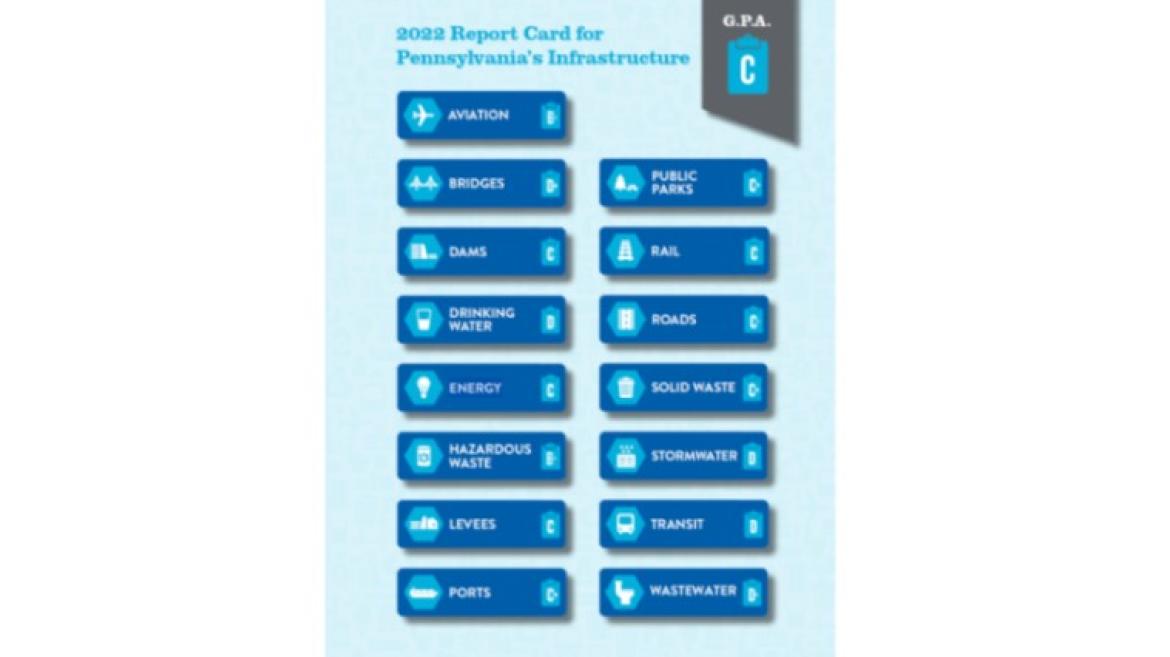
The American Society of Civil Engineers (ASCE) recently published the latest edition of its Pennsylvania Infrastructure Report Card. The report card grades 15 categories of infrastructure in the state, finding an overall grade of C. According to ASCE, that grade indicates, “The infrastructure in the system or network is in fair to good condition; it shows general signs of deterioration and requires attention. Some elements exhibit significant deficiencies in conditions and functionality, with increasing vulnerability to risk.”
ASCE graded each of the 15 infrastructure categories based on eight criteria—capacity, condition, funding, future need, operation and maintenance, public safety, resilience, and innovation. This review presents compelling opportunities for innovation for Pennsylvania’s infrastructure and summarizes the best and the worst findings from the 2022 report card.
Opportunities for Innovation
In one of the most interesting aspects of the national and state report cards, ASCE asks what new techniques, materials, technologies, and delivery methods are being implemented to improve the infrastructure. Infrastructure planning and decision-making must be forward-looking and innovative because major projects are often designed with a 100-year service life. Our way of life has changed significantly in the last 100 years, and it will change significantly in the next 100. While we cannot predict the future, we must be diligent in applying foresight wherever we are able if our service-life projections are to be meaningful.
The COVID-19 pandemic provided a unique—albeit painful—opportunity to glimpse how our infrastructure might be used in the future. Travel and commuting numbers plummeted while usage of broadband and public parks skyrocketed. While many of these effects were temporary, transportation usage data in 2022 show that we are still far from pre-COVID levels. Some effect on commuting patterns may be permanent.
Much of the public may not be aware of the extent that current infrastructure funding is dependent on gas taxes at both the federal and state level. In PA, these taxes have been used to support not only road and bridge construction but also transit and police services. PA has the third-highest gasoline tax rate in the US, and the state tax funds roughly half of PennDOT’s $8.8 billion budget. However, ASCE reports a dramatic gap between that budget and the state’s needs. PennDOT’s budget would need to double to address that gap, and reduced travel has widened it even further.
While our transportation infrastructure is currently funded by gas taxes, vehicle manufacturers and market analysts predict that as many as half of new vehicle sales in the US will be EVs 10 to 15 years from now. These are not the predictions of hopeful environmentalists. They are the predictions of some of the country’s oldest major manufacturers in a highly competitive market, and the companies will live or die by these predictions.
EV sales have been subsidized by tax incentives, but manufacturers are driving costs down. Battery prices continue to decline, major manufacturers have committed large portions of their production to EVs, and the economics for some significant transition to EVs are inevitable. Whether US vehicle sales will be 50% electric 10 years from now or 20 years from now affects only how much time is available to accommodate the transition.
The continued reliance on gas taxes as a funding mechanism must be addressed if any significant shift to electric vehicles occurs. ASCE has recommended a transition toward other funding concepts, such as per-mile usage fees. The technology for such a transition exists, but deployment on a large scale will require time and engineering. Regardless, the transition is necessary to balance infrastructure costs between EVs and internal-combustion vehicles.
PA and other states will also need to develop the infrastructure to support EV charging. In 2022, USDOT provided funding to initiate an expansion of that infrastructure along interstate highways. PennDOT and the PA Department of Environmental Protection jointly coordinate the Drive Electric PA Coalition, one of 24 state coalitions participating in Drive Electric USA, which is funded by the US Department of Energy.
As these initiatives advance, it will be critical to balance urban, suburban, and rural priorities. This has been a long-term challenge in infrastructure investment choices. Past decisions regarding investment in urban transit systems and highways have been politicized, and choices on EV infrastructure will also be. However, public policy debates are a necessary part of making such choices. Politics will play a role in determining who pays for infrastructure and how they do so.
ASCE promotes investment in infrastructure and works to identify gaps between available funding and needs at the state and national level. ASCE recommends that funding be associated with usage and real life-cycle costs as much as possible. As we plan sustainable infrastructure for the next 100 years, we must create sustainable funding mechanisms to support it, which inevitably requires a reduction of our dependence on gas taxes. We must also appreciate the possibility for dramatic changes in usage. The solution may require a combination of fuel taxes, usage fees, and other funding mechanisms. Whatever the source of funding, ASCE recommends that we make a commitment to investing in the infrastructure that drives our economy and impacts our quality of life.
The remainder of this review summarizes the good and the bad news from ASCE’s 2022 PA Infrastructure Report Card. This summary provides a sense of the current state of our infrastructure, an understanding of which is critical to any choices we will make regarding future innovation. New infrastructure will not be sustainable if it is susceptible to unacceptable risks from flooding, sinkholes, structural collapse, and accidents because we have not adequately addressed underlying problems.
The Good News
ASCE did not rate any infrastructure sector as exceptional (A). The infrastructure sectors that received the highest grades were aviation (B-), ports (C+), public parks (C+), solid waste (C+), and hazardous waste (B-). These grades indicate that the infrastructure in these sectors is adequate but may require some attention.
Aviation
Like the rest of the airline industry, PA airports are in the process of recovering from the unprecedented disruption of the COVID-19 pandemic. The number of passenger enplanements at Philadelphia hit an all-time high of more than 16 million in 2019, fell below 6 million in 2020 and returned to 10 million in 2021. In 2022, traffic has returned to about 85 percent of pre-COVID levels at PHL and 65 percent at Pittsburgh.
During the downturn in traffic, the condition and capacity of airports in PA has been improved through projects to expand cargo handling, improve airfields, and enhance terminals. PA has a total of 14 commercial service airports, with Harrisburg, Lehigh Valley, and Wilkes-Barre Scranton seeing the most traffic after PHL and PIT. While the condition of these facilities is generally good, ASCE notes that the limited availability of hangar space is a challenge for the region, that airports could benefit from an increased focus on resiliency, and that system updates associated with the NextGen air traffic control system need to be completed.
Ports
The ports in Erie and Philadelphia move over 100 million tons of goods each year. ASCE highlights the recent completion of dredging in the Delaware River, deepening the channel from 40 feet to 45 feet to accommodate container vessels up to 15% larger than in the past. Philadelphia also added new cranes to accommodate loading and unloading these larger New Panamax vessels. These improvements allow the region to remain competitive with other east coast ports.
Although not directly discussed in the ASCE report card, Philadelphia is a market leader in the shipment of fresh produce to the United States, particularly from Latin America. The handling, repacking, and rail infrastructure in the Philadelphia area provide an unparalleled ability to deliver produce quickly to two thirds of the US population and even to Canada. Recent upgrades to the channel and port allow PA to continue to leverage its geographic, infrastructure, and workforce advantages in this niche of the shipping market. For the future, ASCE recommends that the state improve funding for the ports and ensure that rail capacity is maintained, as private rail companies have reduced track capacity and sold land for real estate development.
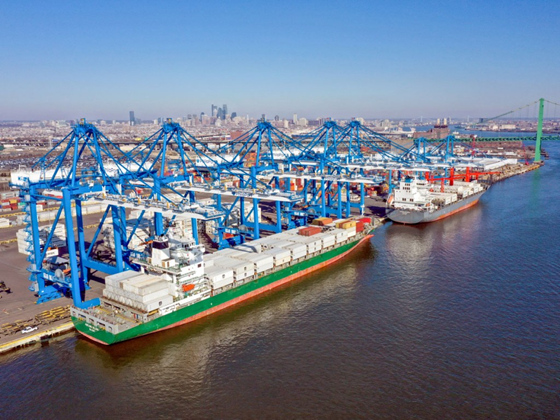
Philadelphia’s Packer Avenue Marine Terminal (Image via American Journal of Transportation)
Public Parks
ASCE notes that parks provide more than just recreation opportunities. They increase natural resilience by treating stormwater runoff, buffering floods, and combating heat island effects. PA has more than 6,000 public parks and 3,000,000 acres of state-owned land, but funding for local parks, particularly in Pittsburgh and Philadelphia has decreased substantially. In parallel, park usage has risen as public demand for outdoor activities increased during the COVID-19 pandemic.
ASCE recommends a more holistic approach to parks to better understand their contributions to environmental management and quality of life. In particular, parks should be better leveraged as a resource for stormwater management, which ASCE considers below standard in PA.
Waste Management
It may not be glamorous, but inadequate waste management infrastructure might be the least tolerable infrastructure gap in a modern state. Fortunately, the condition and capacity of waste management infrastructure across the state rates from adequate to excellent. ASCE evaluated infrastructure for both solid waste (common residential, commercial, and institutional refuse) and hazardous waste (contaminated waste from operating and retired industrial sites).
Solid waste is collected locally recycled, landfilled, or incinerated. Hazardous waste is commonly collected at the source and handled under procedures regulated by the Pennsylvania Department of Environmental Protection (PADEP) and the U.S. Environmental Protection Agency (EPA). PA currently has 90 Superfund sites on the Federal National Priority List (NPL), the third highest number in the nation behind New Jersey and California. ASCE notes, “The relatively high number of NPL sites is largely an artifact of the Commonwealth’s rich industrial history,” and it reports that PA has successfully remediated 99 other sites since 1986. So, PA is moving in the right direction but still has a lot of work to do. ASCE recommends prioritizing remediation of sites in historically disadvantaged, low-income communities, which have borne a disproportionate burden from industrial contamination.
The Bad News
The infrastructure sectors that received the worst grades in ASCE’s 2022 PA report card were Bridges (D+), Transit (D), Drinking Water (D), Stormwater (D), and Wastewater (D-). According to ASCE’s descriptions, these grades reflect infrastructure that is mostly below standard. Many elements are approaching the end of their service life, a large portion of the system exhibits significant deterioration, condition and capacity are of significant concern, and there is a significant risk of failure.
Bridges
PA has a lot of bridges, and many of them are old and in poor condition. The 2022 collapse of Pittsburgh’s Fern Hollow Bridge was an alarming demonstration of what will happen if the condition of these bridges is ignored. ASCE projected an annual investment need of $18 billion for PA highways. The 2021 infrastructure law will help to address this need, but it will provide only 15% of the necessary funding for five years. The gap must be filled by existing and expanded state and federal funding mechanisms.
PA has more than 23,000 highway bridges. More than 12,000 presently need repairs, and more than 3,000 are classified in poor condition. The state has reduced these figures from their peaks in 2017, but investment has decreased due to funding limitations. ASCE indicates a dramatic need for a doubling of PennDOT’s annual budget from $8.8 billion to $18.15 billion. While PennDOT exceeds national safety standards for bridge inspection, bridges in poor condition cannot operate indefinitely without repairs or replacement. Furthermore, the continued reliance on gas taxes as a funding mechanism must be addressed if any significant shift to electric vehicles occurs. Finally, ASCE indicates a need for increased public advocacy to increase support for investment in our bridge infrastructure.
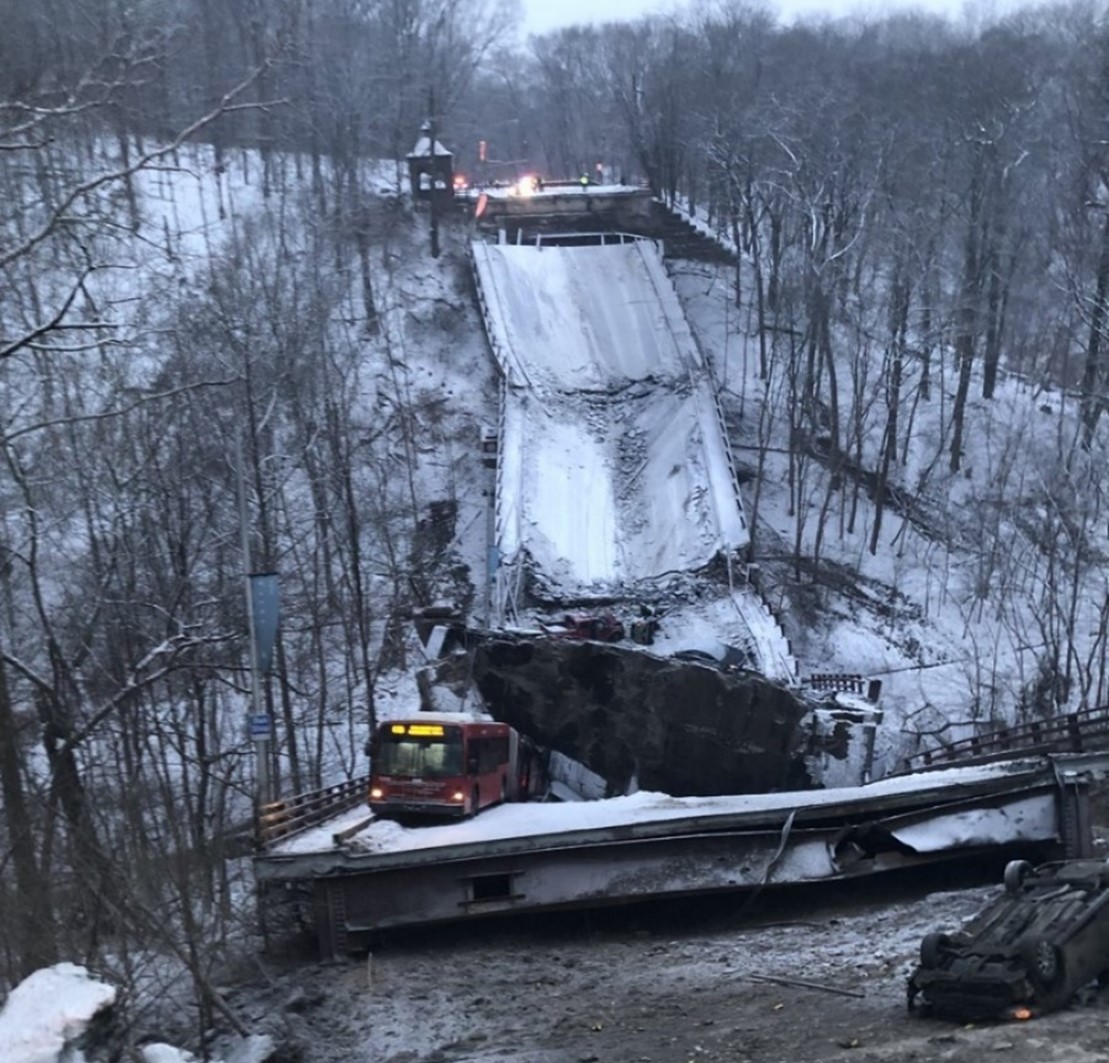
Fern Hollow Bridge Collapse, January 28, 2022 (Image by Pittsburgh Public Safety)
Transit
Pennsylvania’s principal transit systems are SEPTA in the Philadelphia metro region and PRT in the Pittsburgh metro region, but transit touches all counties in the state in the form of buses and shared-ride services. These services are critical infrastructure, particularly for poor, elderly, and disabled riders. Ridership across the state dropped dramatically during the COVID-19 pandemic, with total passenger trips falling by nearly two thirds from 2018 to 2021. Annual trips on SEPTA, the state’s largest system, fell from nearly 300 million to just over 100 million.
Ridership in 2022 has been around half of the pre-COVID baseline. The loss of ridership creates a significant budget gap, but SEPTA generates only about one third of its operating revenue from fares. More than half comes from state funding sources, and the remainder comes from federal and local sources. State funding relies largely on gas taxes and other motor-vehicle fees. SEPTA’s capital budget for 2023 will be the largest in its history at over $1.1 billion. With the increase in federal funding from the 2021 infrastructure law, approximately one third of funding will be federal funds, one third will be state funds, and one third will be raised through bond issues. Still, long-term funding for transit systems requires a long-term, dedicated source of revenue that will meet system needs. Public consensus on transit’s role in U.S. transportation systems has been challenging to reach. Increased public awareness of transit’s less visible presence in rural communities might help to mitigate the sense that current funding mechanisms divert tax revenues from across the state to its two biggest cities, but a permanent solution would require a funding mechanism that does not rely on taxing motor vehicles and liquid fuels.
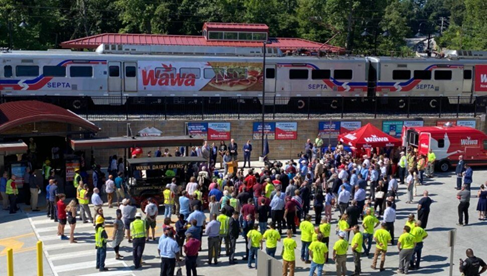
SEPTA opens new Wawa Station in August 2022 (Image by Pete Bannan, MediaNews Group via Delco.today)
Water
Water infrastructure does not attract much attention when it is working well, but anyone who has experienced even a brief loss of access to clean drinking water, functional sanitary sewers, or flooding will recognize that a failed water system represents an immediate crisis. The potential impacts on public health and damage to other infrastructure—through flooding, sinkholes, and contamination—further increase the risks associated with a lack of investment in water systems.
Most PA residents get their drinking water from public water systems. While these systems serve the general public, the underlying infrastructure is owned by a mix of public and private entities, and some of the systems in PA are among the oldest in the country. Pittsburgh’s efforts to replace lead pipes in its drinking water system by 2026 were highlighted as part of ASCE’s national infrastructure report card roll-out. To address issues more holistically, ASCE recommends better asset management systems, a graduated pricing system that better reflects costs of service, and better emergency preparedness.
PA’s stormwater infrastructure generally performs well in low-intensity events, but more intense, frequent, and longer storms have frequently overwhelmed the system. In 2021, Hurricane Ida caused an historic flood in Philadelphia and the loss of lives and over $100 million in damages to property in the state. ASCE notes that annual rainfall changed less than one third of an inch per decade during the 20th Century, but the trend of the past 20 years is seven times higher than for the previous 100. PA will need significant investment to increase the capacity of its systems, or it will face a significant increase in the risk of catastrophic flooding.
Wastewater and stormwater infrastructure is closely related in PA, which has more than 1,600 combined sewer outfalls (CSOs)—17 percent of all CSOs in the US. New combined sewer systems cannot be built in PA by law. However, like many other older cities and towns in the northeast, much of PA’s stormwater infrastructure is hundreds of years old. Separating stormwater and sanitary sewers would require tremendous investment. In the near term, ASCE endorses efforts like the City of Philadelphia’s Green City, Clean Waters Program, which represents a 25-year plan to reduce the volume of stormwater entering the city’s combined sewers.
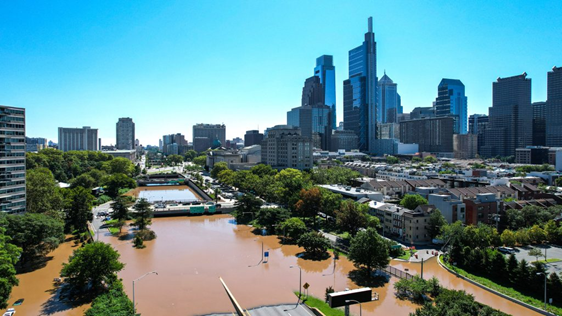
Hurricane Ida floods the Vine Street Expressway in September 2021 (Image by Mark Henninger/Imagic Digital via Billy Penn)
Conclusion
ASCE’s Pennsylvania Infrastructure Report Card presents a useful summary of the condition of the state’s infrastructure and its future needs. It should be used as a starting point to drive public discussion on infrastructure investment, particularly where there are critical funding gaps, as there are in transit and water systems. Some of our infrastructure has served us for many generations, and major elements are now approaching the end of their service life. Choosing the right investments now, with a focus on the future, will have significant impacts on the economy and on the quality of life in the state for generations to come.
